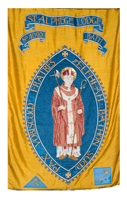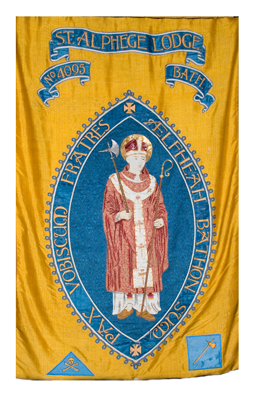The establishment of a new Lodge in Bath was first considered on 14th November,1919. when the name proposed was “The William Long Lodge”. Grand Lodge however would not sanction a new Lodge named after a living person and it was therefore agreed to name the Lodge “St. Alphege”
Why St. Alphege? In 954, a boy was born of Saxon parents destined to become a monk, an Abbot, a Bishop, Arch Bishop of Canterbury and a Martyr. Alphege came to the City of Bath in 973 and after spending three years in solitude was persuaded to become Abbot of Bath in 976 and to reform the Abbey along the lines of Benedictine Rule. Later in 984 he moved to the important See of Winchester as Bishop and finally at the age of 52 he succeeded Alfric as Archbishop of Canterbury. Five years later he was imprisoned by the Danes and the following year after refusing to betray his trust he was put to death by stone and axe at Greenwich.
St. Alphege Lodge was consecrated at the Masonic Hall, Bath, on 6th September, 1920 by the R.W. Brother Colonel William Long, C.M.G., Provincial Grand Master. He was assisted by Worshipful Brother Colonel A. Thrale Perkins, C.B., P.G.D., D.P.G.M
The consecrating officer said one of the four Lodges in Bath had become unduly large, and a number of brethren had petitioned the Grand Master, His Royal Highness the Duke of Connaught, who had graciously acceded to their request to issue a Warrant for the new Lodge. There were 50 founder members and it was agreed that the Ritual should be that used by both the Royal Cumberland and the Royal Albert Edward Lodges.
A report of the consecration appeared in the ‘Bath Herald’ of 7th September, 1920, written by Brother Herbert Staines of the Royal Albert Edward Lodge, No. 906, and one of the founder members. The report stated that in the course of the consecration ceremony the Provincial Grand Master had referred to the City of Bath as one of the keenest places in Masonry which he knew
On 3rd March, 1928, the banner of the Lodge was dedicated by the Rt. Worshipful Provincial Grand Master of Somerset, the Venerable Walter Farrer, Archdeacon of Wells. Thus although consecrated in September, 1920, it had no banner for eight years. The design of the banner shows a full length figure of St. Alphege together with implements and emblems of his martyrdom. It was designed by Bros. A.J. Taylor and A. C. Fare and the embroidery was by a Miss Hyatt, of Limpley Stoke. The Latin inscription on the border “Pax Vobiscum Frates Aelfheah Bathon Sum” means “Peace be with you, brethren, I am Alphege of Bath”
During the Second World War the Masonic Hall at Bath, was badly damaged during air raids, and meetings were held at Keynsham for a short period. All Lodge records and property were preserved. A service of thanksgiving for the restoration of peace was held at the Church of the Ascension, Bath, on Sunday, 17th June, 1945, when the address was given by W. Bro. J. Macdonald Richardson, P.G.Ch. On 5th October, 1946, a record was made of the names of members who had served in the Forces and in the Civil Defence. During the air raids on Bath two members, Bros. W. McDougall and C. D. James were killed while on duty in the Civil Defence. Bro. F. R. Elliot of the Royal Navy lost his life at sea
The year 1948 proved to be a sad year for the Lodge when in the month of April within the space of twelve days the Lodge lost both W. Bro. W. T. Ellery and W. Bro. W.A. Gayner who had been respectively Secretary and Treasurer of the Lodge since its Foundation. The W. Master, W. Bro. T.C. W. Inskip paid tribute to their high standard of work and efficiency which would set a pattern for every brother of the the Lodge
More generally it is of interest to all local freemasons that Craft Masonry in Bath dates back to 1723-24, when two Lodges were established. The original Lodge which met in Union Passage was the first in the provinces to be recognised by Grand Lodge. The second Lodge met at the Bear Inn, then on the opposite corner of the Passage. This was the Royal Cumberland Lodge.
After meetings in other local hostelries the Lodges met at the New Masonic Hall in York Street in 1819. The foundation stone of this new Masonic Hall was laid on 4th August, 1817 and the premises opened on 23rd September, 1819. The building ultimately became the property of the Society of Friends.
The Lodges continued to meet in hostelries or at the Corridor Rooms until 1866 when the present building which had formerly been the Theatre Royal and a Roman Catholic Church was bought by the Royal Sussex Lodge as a Masonic Hall with the Royal Cumberland Lodge and Lodge of Honour as tenants.
The building is steeped in history and associate with many famous names in the Theatrical World. To this day many original features of the Theatre can be seen around the building and on the dias behind the Worship Master’s Chair there are pictures by John Barker a well known Bath artist depicting King Solomon, Hiram King of Tyre and Hiram Abif.
There is a large oil painting in the West of ‘Bethesda’ by William Hoare, 1768. It came from the Octagon Chapel, Bath, and was presented by Charles W. Radway of the Royal Cumberland Lodge in 1896.
A great deal more could be written on the history of Freemasonry not only in Bath but in the Province of Somerset. After its consecration in 1920 St. Alphege Lodge has played a very small but we trust, important part in promoting the good of Freemasonry and may we continue to preserve our Order and strive to set a standard, which will be an example to others and a credit to ourselves from generation to generation.

